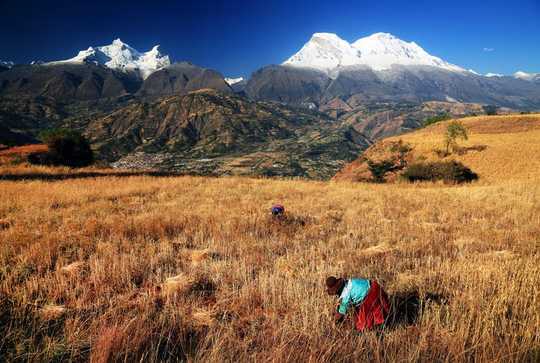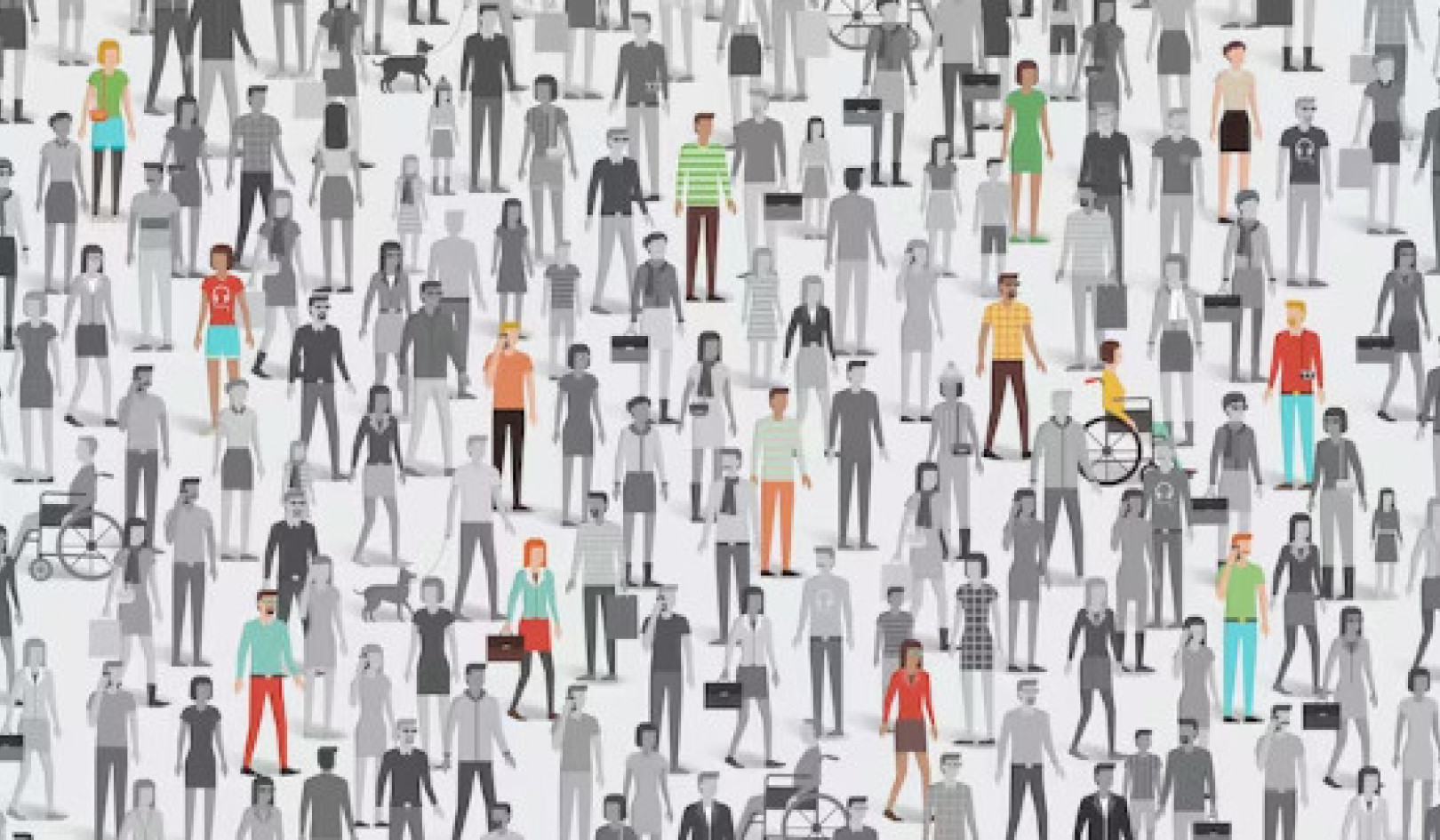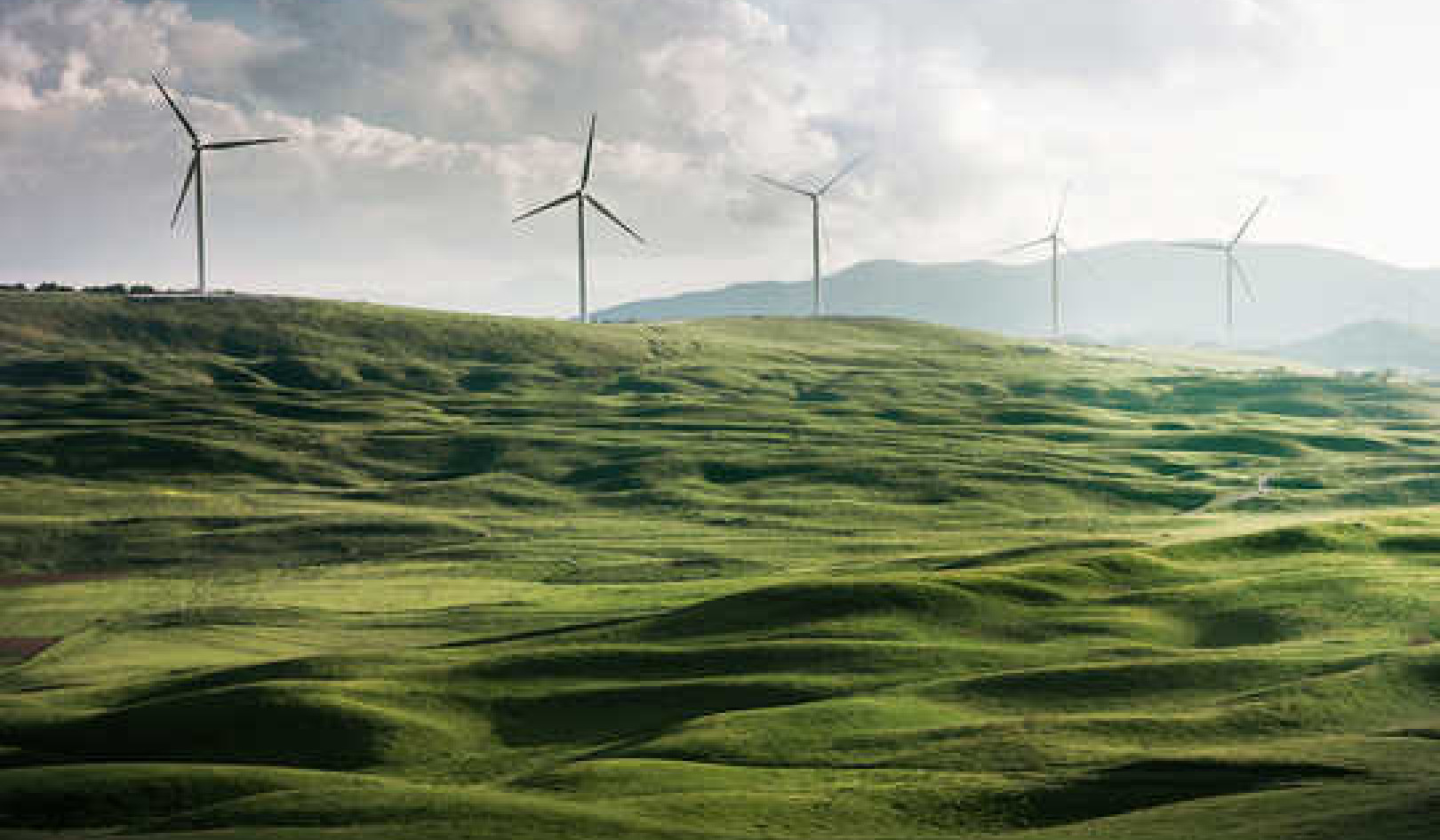
Harvesting wheat in the Peruvian Andes. Shutterstock.
Water is essential for human life, but in many parts of the world water supplies are under threat from more extreme, less predictable weather conditions due to climate change. Nowhere is this clearer than in the Peruvian Andes, where rising temperatures and receding glaciers forewarn of imminent water scarcity for the communities that live there.
Peru holds more than 70% of the world’s tropical glaciers. Along the 180 kilometre expanse of the Cordillera Blanca (“white mountains”), more than 250,000 people depend on glaciers for a year-round supply of water. Meltwater from the glaciers supplies rivers, offering a vital supplement to rainwater so that locals can continue irrigating food crops throughout the dry season, from May to October.
But Peruvian glaciers have shrunk by 25% since 1987, and the water supply to rivers during the dry season is gradually decreasing. While national and regional governments and NGOs are responding to the threat of water scarcity with modern engineering solutions, there are growing concerns among the communities affected that such efforts are misplaced.
Modern day misfires
Take, for example, the village of Huashao. Nestled between the highest peaks of the Cordillera Blanca, Huashao is a typical farming village of the region. Glacier meltwater feeds the Yurac Uran Atma canal, which supplies irrigation water to families in Huashao. In 2011, a municipal government project transformed this canal from a rustic irrigation ditch to a modern PVC pipeline, with lock-gates to regulate the flow of water and ensure equal distribution throughout the village.

The village of Huashao. ConDevCenter/Flickr., CC BY-NC-ND
Governments and NGOs commonly promote modern measures to capture and conserve water for irrigation – for example, by lining irrigation canals with concrete, to prevent leakages. While it’s important to conserve water to safeguard food supplies, these kinds of measures have been criticised for their lack of flexibility and sensitivity to local needs.
While the pipeline in Huashao provided security and reduced the amount of time people had to devote to distributing water where it was needed, Conlon’s ongoing ethnographic research in the village found that local women were concerned about its effect on the local puquios (springs) – a valued source of irrigation and drinking water.
Noticing less water in puquios, they blamed the canal lining for stopping water from filtering into the local geology. Local communities see this process as an integral part of water distribution, but authorities often refer to it as “leakage”.
What’s more, the local people responsible for maintaining and operating the new canal found that not everything worked as planned. They were particularly worried when a problem caused water to overflow the canal walls, and blamed the design of the lock–gates.
Here, the government’s preference for modern engineering meant that it missed an opportunity to engage with traditional technologies and local knowledge. This is hardly surprising – ancient know-how has been routinely dismissed as inferior by state authorities and well-meaning (but badly briefed) NGOs. Yet traditional technologies, like the puquios, have been providing flexible ways to manage water in Huashao for hundreds of years.
In Huashao, the local people are coming to realise the limitations of modern engineering. But across the Andes, many other communities are still seduced by the promise of quick fixes offered by concrete, steel and PVC pipelines. Unfortunately, initial, costly investments of aid and expertise are rarely followed up, and since communities often lack the necessary knowledge and funds to maintain these systems, they eventually break down.
Ancient married with modern
Slowly, a push back is starting. There has been renewed interest in what society can learn from traditional irrigation systems. A recent international workshop held in Trujillo, Peru, brought together social scientists, geographers and climate scientists to discuss how to tackle issues around water use and scarcity.
It seems likely that the best solutions will be found by combining old and new knowledge, rather than dismissing one in favour of the other. For instance, parallel to the Cordillera Blanca is the Cordillera Negra (“black mountains”), which faces the Pacific Ocean. Without the benefit of glaciers, the ancient inhabitants of this area learned to harness rain water to see them through the dry season.
These pre-Colombian cultures instigated millennia-long engineering projects, resulting in large dams and reservoirs placed along the slopes of the mountains. These structures controlled water and soil erosion, feeding underground water deposits and providing water for crops and livestock.

An ancient dam in the Cordillera Negra. Kevin Lane., Author provided
Disuse over the last few centuries means that few are still functioning, but those that are, are a tribute to the ancient expertise. By contrast, modern concrete micro-dams have a functional life of 40 to 50 years, often curtailed by seismic activity to between 15 and 25 years.
Fortunately, plans are afoot to revisit these old technologies. Solutions rooted in respect for community and local knowledge, and allied to flexible modern engineering – such as better water retainment technology – are exploring ways in which we can shore-up the effectiveness of these ancient dams.
Throwing money and resources into engineering projects does not always guarantee success when trying to combat the effects of climate change and protect vulnerable communities. But the marriage of ancient and modern technologies offers promising solutions to the threat of water scarcity in Peru, and places like it all across the world.![]()
About The Authors
Susan Conlon, Research Associate, University of Bristol and Kevin Lane, Senior Researcher in Archaeology, Universidad de Buenos Aires
This article is republished from The Conversation under a Creative Commons license. Read the original article.
Related Books
Climate Adaptation Finance and Investment in California
by Jesse M. Keenan This book serves as a guide for local governments and private enterprises as they navigate the unchartered waters of investing in climate change adaptation and resilience. This book serves not only as a resource guide for identifying potential funding sources but also as a roadmap for asset management and public finance processes. It highlights practical synergies between funding mechanisms, as well as the conflicts that may arise between varying interests and strategies. While the main focus of this work is on the State of California, this book offers broader insights for how states, local governments and private enterprises can take those critical first steps in investing in society’s collective adaptation to climate change. Available On Amazon
This book serves as a guide for local governments and private enterprises as they navigate the unchartered waters of investing in climate change adaptation and resilience. This book serves not only as a resource guide for identifying potential funding sources but also as a roadmap for asset management and public finance processes. It highlights practical synergies between funding mechanisms, as well as the conflicts that may arise between varying interests and strategies. While the main focus of this work is on the State of California, this book offers broader insights for how states, local governments and private enterprises can take those critical first steps in investing in society’s collective adaptation to climate change. Available On Amazon
Nature-Based Solutions to Climate Change Adaptation in Urban Areas: Linkages between Science, Policy and Practice
by Nadja Kabisch, Horst Korn, Jutta Stadler, Aletta Bonn This open access book brings together research findings and experiences from science, policy and practice to highlight and debate the importance of nature-based solutions to climate change adaptation in urban areas. Emphasis is given to the potential of nature-based approaches to create multiple-benefits for society.
This open access book brings together research findings and experiences from science, policy and practice to highlight and debate the importance of nature-based solutions to climate change adaptation in urban areas. Emphasis is given to the potential of nature-based approaches to create multiple-benefits for society.
The expert contributions present recommendations for creating synergies between ongoing policy processes, scientific programmes and practical implementation of climate change and nature conservation measures in global urban areas. Available On Amazon
A Critical Approach to Climate Change Adaptation: Discourses, Policies and Practices
by Silja Klepp, Libertad Chavez-Rodriguez This edited volume brings together critical research on climate change adaptation discourses, policies, and practices from a multi-disciplinary perspective. Drawing on examples from countries including Colombia, Mexico, Canada, Germany, Russia, Tanzania, Indonesia, and the Pacific Islands, the chapters describe how adaptation measures are interpreted, transformed, and implemented at grassroots level and how these measures are changing or interfering with power relations, legal pluralismm and local (ecological) knowledge. As a whole, the book challenges established perspectives of climate change adaptation by taking into account issues of cultural diversity, environmental justicem and human rights, as well as feminist or intersectional approaches. This innovative approach allows for analyses of the new configurations of knowledge and power that are evolving in the name of climate change adaptation. Available On Amazon
This edited volume brings together critical research on climate change adaptation discourses, policies, and practices from a multi-disciplinary perspective. Drawing on examples from countries including Colombia, Mexico, Canada, Germany, Russia, Tanzania, Indonesia, and the Pacific Islands, the chapters describe how adaptation measures are interpreted, transformed, and implemented at grassroots level and how these measures are changing or interfering with power relations, legal pluralismm and local (ecological) knowledge. As a whole, the book challenges established perspectives of climate change adaptation by taking into account issues of cultural diversity, environmental justicem and human rights, as well as feminist or intersectional approaches. This innovative approach allows for analyses of the new configurations of knowledge and power that are evolving in the name of climate change adaptation. Available On Amazon
From The Publisher:
Purchases on Amazon go to defray the cost of bringing you InnerSelf.comelf.com, MightyNatural.com, and ClimateImpactNews.com at no cost and without advertisers that track your browsing habits. Even if you click on a link but don't buy these selected products, anything else you buy in that same visit on Amazon pays us a small commission. There is no additional cost to you, so please contribute to the effort. You can also use this link to use to Amazon at any time so you can help support our efforts.

























